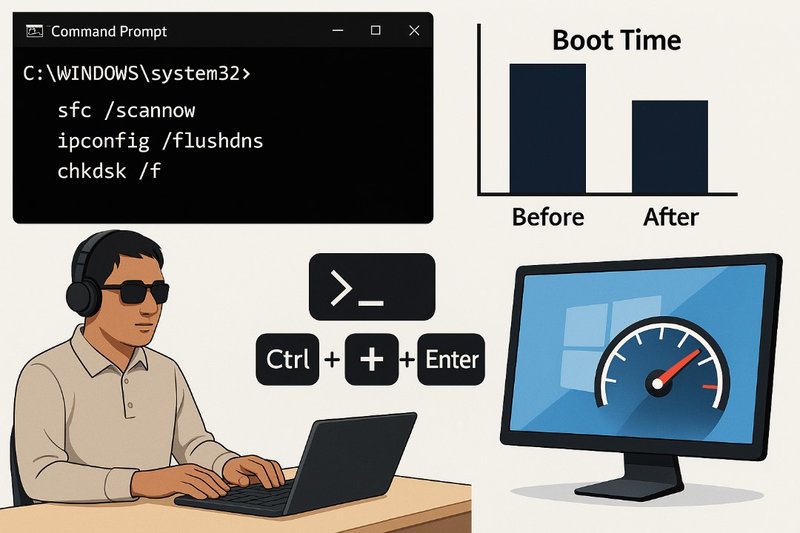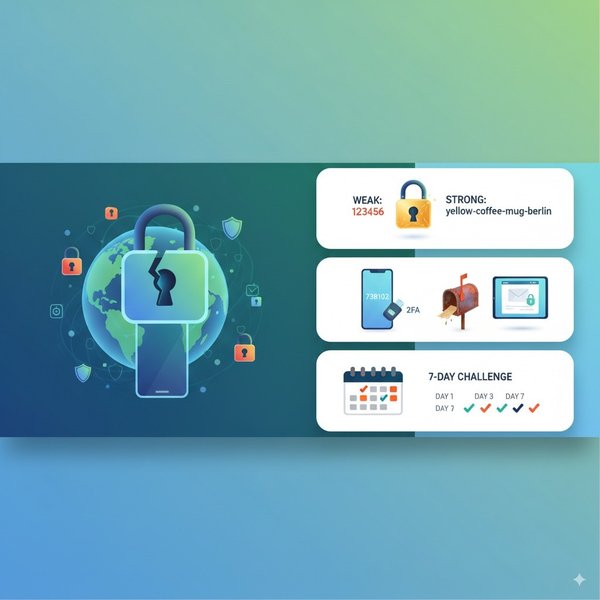🔊 This guide is fully accessible — written for everyone, including blind, low-vision, screen reader users, seniors, and keyboard-only users. It teaches how to speed up a slow Windows computer using Command Prompt (CMD) — no extra software required.
When your computer starts taking too long to boot, open apps, or connect to the internet, it’s not always because of a virus or lack of memory. Often, it’s just clutter — leftover files, unused startup apps, corrupt system processes, or unnecessary visuals weighing down your machine. The good news? You can clean, repair, and optimize your entire system using built-in tools — all from a single powerful interface: the Command Prompt, also known as CMD.
What is Command Prompt?
CMD is a tool in Windows that lets you talk directly to the operating system by typing commands. It’s like the control room behind the scenes — allowing you to delete junk files, check for errors, reset your network, manage startup programs, and much more — all without needing to open dozens of windows or use a mouse. Best of all, it’s completely screen reader–friendly and ideal for keyboard-only users.
This guide will teach you step-by-step how to use CMD to speed up your PC, clean it, and reduce boot time. You’ll learn everything from basic cleanup to advanced performance tuning — formatted for full mastery.
🧹 Clean Temporary Files (Using CMD Only)
Open Command Prompt as Administrator:
-
Press
Windows + S -
Type
cmd -
Press
Ctrl + Shift + Enter -
If prompted, press
Alt + Yto approve admin access
Delete Temporary Files:
del /q/f/s %TEMP%\*
Delete Prefetch Files:
del C:\Windows\Prefetch\*.* /q
🧪 Run System File Checker (SFC)
sfc /scannow
Scans for and repairs missing or corrupted system files. This process may take up to 15–20 minutes.
🔧 Repair Windows Image Using DISM
DISM /Online /Cleanup-Image /RestoreHealth
Fixes deeper Windows errors that SFC might not resolve, especially after system updates.
🧼 Deep Clean Disk Space
Launch Disk Cleanup Tool:
cleanmgr /sageset:1
cleanmgr /sagerun:1
Use arrow keys to select items to clean (like system logs and old updates). Press Tab to reach "OK", then press Enter.
Quick Cleanup with Defaults:
cleanmgr /verylowdisk
Runs automatically with essential cleanup items selected.
🐇 Enable Hibernate and Fast Startup
Enable Hibernate:
powercfg -h on
Turn on Fast Startup (keyboard steps):
-
Press
Windows + R, typecontrol, pressEnter -
Press
Tabto "Hardware and Sound", pressEnter -
Press
Tabto "Power Options", pressEnter -
Press
Tabto "Choose what the power buttons do", pressEnter -
Press
Tabto “Change settings that are currently unavailable”, pressEnter -
Use arrow keys to highlight “Turn on fast startup”, press
Space -
Press
Tabto Save Changes, then pressEnter
🛠 Disable Unnecessary Startup Programs
View Startup Items:
wmic startup get caption,command
Make note of programs you don’t need to launch automatically (e.g., Skype, Adobe Updater, Spotify).
Disable Startup Apps Using Keyboard:
-
Press
Ctrl + Shift + Escto open Task Manager -
Press
Tabto the top tabs, use arrow keys to reach “Startup” -
Press
Tabto focus the app list -
Use arrow keys to select an app
-
Press
Enter, arrow down to “Disable”, pressEnter -
Repeat as needed
🖥️ Disable Visual Effects for Performance
Open Performance Settings:
SystemPropertiesPerformance
-
Use arrow keys to highlight “Adjust for best performance”
-
Or manually uncheck visual options (e.g., shadows, animations) using spacebar
-
Press
Tabto Apply, then pressEnter
🌐 Flush DNS and Reset Network Stack
Flush DNS Cache:
ipconfig /flushdns
Reset Network:
netsh winsock reset
Restart your system after both commands.
⏱ Check Boot Time
systeminfo | find "Boot Time"
Displays your last system boot time. Helps measure improvement after cleanup.
⚙ Advanced Boot Configuration
Open System Configuration:
msconfig
-
Use
Taband arrow keys to move to the “Boot” tab -
Enable “No GUI boot” to disable boot animations
-
Move to the “Services” tab
-
Press
Tabto reach service list -
Press
Spaceto check “Hide all Microsoft services” -
Use arrow keys to disable unneeded services
-
Press
Alt + Ato Apply, thenAlt + Oto OK -
Restart your PC
🔋 Optimize Power Plan for Performance
View Available Power Plans:
powercfg /list
Activate High Performance Mode:
powercfg /setactive SCHEME_MIN
Improves speed on laptops and desktops by allocating more power to performance.
🧾 Optional: Clear Browser Cache from CMD
Clear Internet Explorer / Edge Data:
RunDll32.exe InetCpl.cpl,ClearMyTracksByProcess 255
Clears cookies, browsing history, and temporary files.
🧰 Optional: Run Full Security Scan (Windows Defender)
MpCmdRun -Scan -ScanType 2
Performs a deep system scan using the built-in antivirus tool. Results are logged automatically.
📋 Summary of Key Commands
| Purpose | Command |
|---|---|
| Delete temp files | del /q/f/s %TEMP%\* |
| Delete prefetch cache | del C:\Windows\Prefetch\*.* /q |
| System file scan | sfc /scannow |
| Repair Windows image | DISM /Online /Cleanup-Image /RestoreHealth |
| Disk cleanup | cleanmgr /sagerun:1 |
| Enable hibernate | powercfg -h on |
| Check startup apps | wmic startup get caption,command |
| Flush DNS cache | ipconfig /flushdns |
| Reset Winsock | netsh winsock reset |
| View boot time | `systeminfo |
| Set power plan | powercfg /setactive SCHEME_MIN |
| Full Defender scan | MpCmdRun -Scan -ScanType 2 |
| Clear browser data | RunDll32.exe InetCpl.cpl,ClearMyTracksByProcess 255 |
🧠 Automate the Process With One Script (Advanced)
Create a Boost Script:
-
Press
Windows + R, typenotepad, pressEnter -
Paste the content below
-
Press
Ctrl + Sto save -
In the File Name box, type:
boost.cmd -
In "Save as type", select "All Files", then press
Enter -
Right-click the file and select "Run as Administrator" using keyboard: Press
Shift + F10, then arrow to "Run as administrator", pressEnter
@echo off
echo Cleaning temporary files...
del /q/f/s %TEMP%\*
del C:\Windows\Prefetch\*.* /q
echo Running system file check...
sfc /scannow
echo Repairing Windows image...
DISM /Online /Cleanup-Image /RestoreHealth
echo Flushing DNS...
ipconfig /flushdns
echo Resetting network stack...
netsh winsock reset
echo Enabling Hibernate and Fast Startup...
powercfg -h on
echo Done. Please restart your computer.
pause
Let us know your taught at the comment section.




Comments (0)
Leave a Comment
No comments yet. Be the first to comment!